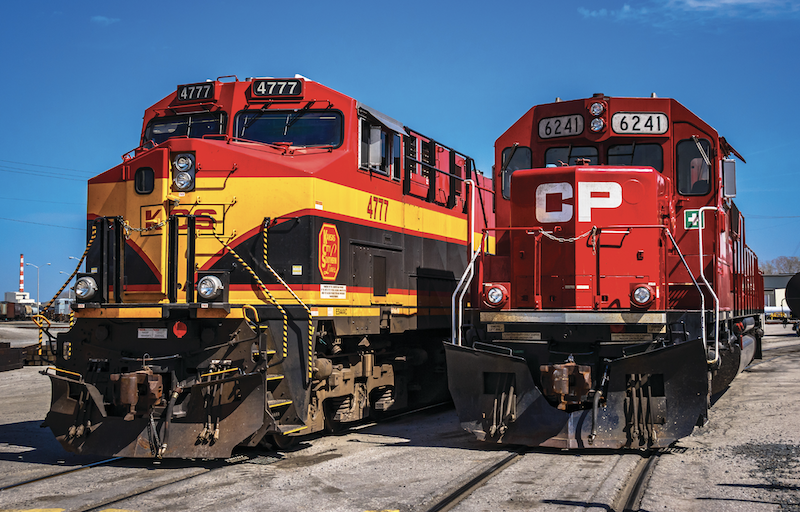Canadian Pacific Kansas City

Canadian Pacific Kansas City
Canadian Pacific Kansas City (CPKC) represents a significant merger in the North American railroad industry, combining the strengths of Canadian Pacific Railway (CP) and Kansas City Southern (KCS). This integration, finalized in 2023, created the first single-line railway network connecting Canada, the United States, and Mexico, thereby enhancing cross-border trade and logistical efficiency. The merger, valued at $31 billion, holds substantial implications for commerce, transportation, and economic growth across the continent. This comprehensive overview delves into the history, strategic significance, operational integration, economic impacts, and future prospects of CPKC.
Historical Background of Canadian Pacific Kansas City
Canadian Pacific Railway (CP)
Founded in 1881, the Canadian Pacific Railway played a pivotal role in the development of Canada’s economy and infrastructure. Initially constructed to fulfill a promise of a transcontinental railway, CP linked the eastern provinces with the Pacific coast, facilitating settlement and economic expansion. Over the years, CP evolved from primarily a freight and passenger service into a diversified transportation and logistics provider, focusing on bulk commodities, intermodal freight, and specialized transport services.
Kansas City Southern (KCS)
Kansas City Southern, established in 1887, originated as a regional railroad serving the Midwestern United States. It expanded through strategic acquisitions and partnerships, notably extending its reach into Mexico through the acquisition of Grupo TFM (now Kansas City Southern de México) in 1995. KCS’s north-south corridor became increasingly vital for trade between the U.S. and Mexico, particularly under the North American Free Trade Agreement (NAFTA) and its successor, the United States-Mexico-Canada Agreement (USMCA).
Strategic Significance of the Merger of Canadian Pacific Kansas City
The CPKC merger represents a strategic move to capitalize on the growing interdependence of the North American economies. The integrated network spans over 20,000 miles, creating seamless connections between key markets in Canada, the U.S., and Mexico. This merger is poised to streamline supply chains, reduce transit times, and enhance the reliability of rail services across the continent.
Trade and Economic Integration of Canadian Pacific Kansas City
North America’s trade landscape has been shaped significantly by free trade agreements like NAFTA and USMCA. CPKC’s network alignment supports these agreements by facilitating efficient cross-border transportation. Key industries, such as automotive, energy, agriculture, and manufacturing, stand to benefit from improved logistics and reduced transportation costs. The unified network enhances the competitiveness of North American goods in global markets, fostering economic growth and job creation.
Operational Synergies
Combining CP’s robust infrastructure and extensive Canadian network with KCS’s strategic north-south corridor into Mexico creates operational synergies. These include optimized route planning, improved asset utilization, and reduced operational redundancies. Enhanced intermodal services and increased capacity for bulk commodities like grain, oil, and automotive parts are anticipated benefits. Additionally, CPKC aims to leverage technological advancements in rail operations, such as precision scheduled railroading (PSR), to improve efficiency and service reliability.
Economic Impacts

Regional Development in Canadian Pacific Kansas City
The creation of CPKC is expected to stimulate regional development across North America. By providing more efficient and reliable transportation options, the merged entity can attract new businesses and industries to areas along its network. This is particularly relevant for regions in Mexico and the U.S. Midwest that rely heavily on rail transport for economic activities.
Job Creation and Workforce Development
The merger is projected to create thousands of jobs directly within the railway and indirectly through increased economic activity. CPKC has committed to workforce development initiatives, including training programs for employees and partnerships with educational institutions to cultivate the next generation of rail professionals.
Environmental Considerations
CPKC’s integrated network can potentially reduce the overall carbon footprint of freight transportation in North America by shifting more cargo from trucks to trains. The merger also aligns with broader sustainability goals by investing in cleaner technologies and fuel-efficient locomotives.
Operational Integration
Infrastructure Investments
CPKC has announced plans for significant infrastructure investments to enhance capacity and efficiency. These include upgrading rail lines, expanding terminals, and modernizing facilities. In Mexico, CPKC aims to invest in key corridors to support growing trade volumes, particularly in automotive and energy sectors.
Technological Innovations in Canadian Pacific Kansas City
Leveraging technology is a critical aspect of CPKC’s strategy. Implementing advanced signaling systems, predictive maintenance tools, and real-time tracking capabilities will enhance operational efficiency and safety. Precision Scheduled Railroading (PSR) principles will be applied to optimize train schedules, reduce dwell times, and improve asset utilization.
Customer Experience
A key focus for CPKC is enhancing the customer experience. The merger aims to provide customers with a seamless, integrated service offering across the entire network. This includes streamlined booking processes, improved transparency through real-time tracking, and dedicated customer support teams. CPKC also plans to expand its intermodal services, providing shippers with more flexible and reliable transportation options.
Future Prospects in Canadian Pacific Kansas City
Growth Opportunities
CPKC is well-positioned to capitalize on several growth opportunities. The increasing trend of nearshoring – relocating production closer to end markets – particularly in Mexico, is expected to boost rail volumes. Additionally, the energy sector, including crude oil, natural gas, and renewable energy components, represents a significant growth area for the merged entity.

Competitive Landscape
In a highly competitive railroad industry, CPKC’s extensive network and operational efficiencies provide a competitive edge. The merger positions CPKC to compete effectively with other major North American railroads, such as Union Pacific, BNSF, and CSX. By offering comprehensive north-south connectivity, CPKC differentiates itself in the market.
Regulatory and Compliance Challenges in Canadian Pacific Kansas City
Navigating the regulatory landscape is a critical aspect of CPKC’s operations. Ensuring compliance with safety, environmental, and trade regulations in Canada, the U.S., and Mexico is essential for smooth operations. The merger has been subject to scrutiny by regulatory bodies, emphasizing the need for transparent and responsible business practices.
Conclusion
Canadian Pacific Kansas City (CPKC) marks a transformative chapter in the North American railroad industry. The merger of CP and KCS creates a unified network that enhances trade connectivity, operational efficiency, and economic growth across Canada, the United States, and Mexico. With strategic investments in infrastructure, technology, and workforce development, CPKC is poised to become a leading player in the global logistics landscape.
The integration of these two historic railroads brings forth numerous benefits, from streamlined supply chains and reduced transit times to environmental sustainability and job creation. As CPKC navigates the challenges and opportunities ahead, its success will be measured by its ability to deliver value to customers, shareholders, and the broader North American economy. The formation of CPKC not only reshapes the railroad industry but also reinforces the critical role of rail transportation in driving economic prosperity and regional development in an increasingly interconnected world.
In case, if you need help with Work Visa or other Immigration Services in Canada, please fill in application below or contact us directly.

